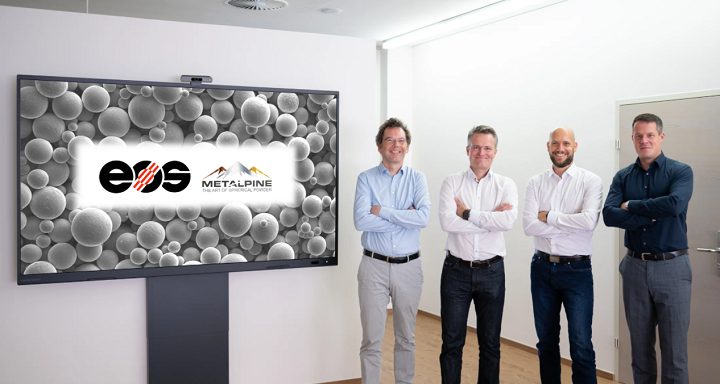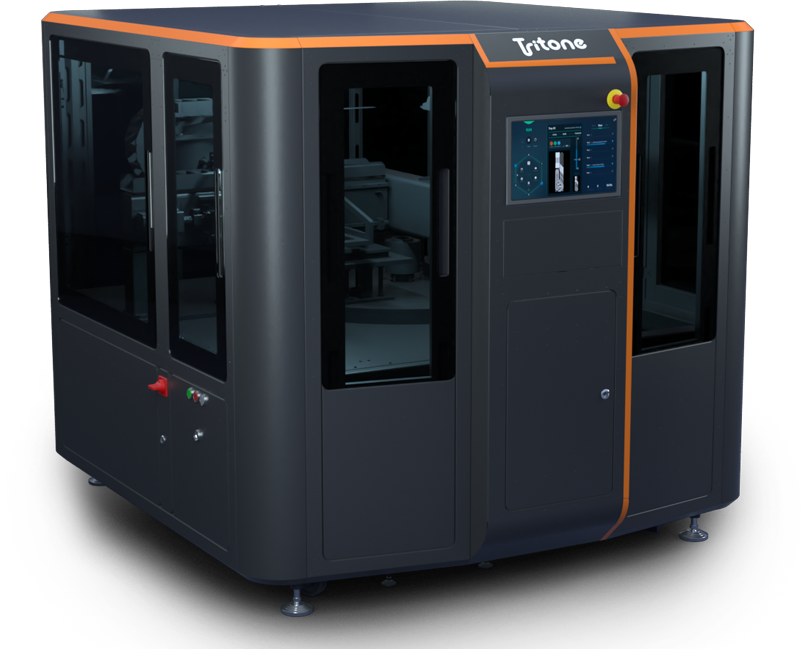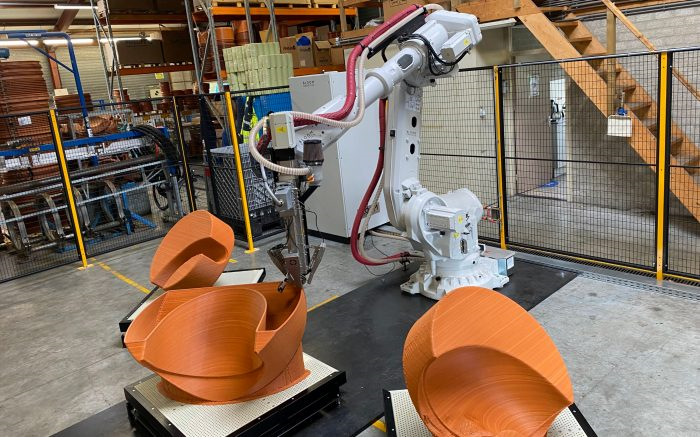In today’s 3D Printing News Briefs, we’re starting off with three new large 3D printers, before moving on to some new materials. Finally, we’ll end with serial 3D printing of manhole covers. Read on for all the details!
Prusa Research Introduces Large-Format XL Printer
Czech company Prusa Research released the Prusa Mini in 2019, which is smaller than its popular Prusa Mk3s, and has now unveiled the large-format Prusa XL, which is the company’s largest 3D printer to date. With a build volume of 14.17 x 14.17 x 14.17″, the new Prusa XL is twice as large as the Mk3s, and differs from the company’s smaller systems in that it is based on the CoreXY system, where a gantry moves the print head on the X and Y axis and the build plate moves down on the Z axis; this offers more stability when making tall prints. The XL also features a modular heating system, which keeps everything even and cuts down on warping by heating smaller cells on the print bed only as needed—often a major issue with large-format printers.
The Prusa XL includes a new extruder system, called the Nextruder, which the company says will ensure automated bed leveling without a live Z-adjustment, thanks to a 20:1 gear ratio that feeds filament accurately through a heat block. Additionally, the printer has an optional upgrade that allows up to five independent toolheads for not only different colors of filaments but also different kinds of materials and print temperatures as well. The new Prusa XL is available for preorder at a refundable deposit of $199, and shipping is scheduled to begin in Q2 or Q3 of 2022.
Anisoprint Introduces Largest Industrial 3D Printer
Luxembourg company Anisoprint has also unveiled its largest industrial 3D printer to date: the PROM IS 500, with a 600 x 420 x 300 mm build volume and featuring adjustable manufacturing volumes and flexible fiber trajectories to enable the use of both continuous fiber-reinforced composites and high-temperature polymers. The printer meets industrial standards for tolerance, safety, and reliability thanks to the Bosch Rexroth MTX CNC system, and comes with an ecosystem of software, including Aura and Composer. The new PROM IS 500 has a tool changer for up to four printheads with CCF and FFF extruders, and its database will be continually updated with new materials and verified profiles.
The printer will launch with ten beta users, and testing should take about six months. Beta testers for the PROM IS 500 will be required to work closely with Anisoprint engineers, so a location in Europe is preferable, and they must come up with a valid industrial use case that can be publicly shared. Additionally, potential beta testers must offer diversity in their company (small, medium, and large), applications, industries, and markets. Any feedback provided will allow Anisoprint to fix possible issues, incorporate necessary features for a functional machine, and enable improved reliability. Visit the Anisoprint website if interested.
Tritone Expanding Moldjet Line with DIM Metal 3D Printer
Israel-based Tritone Technologies is growing its product line with the new Tritone DIM mid-range metal printer, which is powered by the company’s patent-pending Moldjet technology. In this process, a mold is produced as a negative of the component, using inkjet-like print heads, out of a wax-like polymer. The printed layer is filled in a slot-die process with water-based metal powder paste, and this process builds up the part layer by layer, allowing for supportless undercuts and internal channels, before the surrounding mold is removed—leaving the 3D green part for heat treatment and sintering. The new DIM system has a build volume of 220 x 120 x 90 mm over four trays, and is meant to be used in by R&D and educational departments, consumer goods and consumer electronics manufacturers, and service bureaus to create end-use metal parts.
“Our propriety technology is a game-changer in the AM industry. Tritone’s solution can facilitate any shape, design and complexity for fast go-to-market industrial production,” said Omer Sagi, VP Products and Business Development at Tritone. “After the initial success of our Dominant system, we are proud to expand our market reach with the DIM system. The market is ready to shift gear from prototyping to production of high-quality metal parts, and we are proud to be at the forefront of this emerging revolution.”
EOS & Metalpine Developing Sustainable Metal Powder Solutions

L-R: Dr. Martin Dopler and Gerald Pöllman, Metalpine; Sascha Rudolph, EOS; Andreas Rohrseitz, htm Invest group
Moving on from 3D printers, EOS has acquired a minority stake in Austrian company Metalpine, a subsidiary of the htm invest group, and together the two plan to jointly develop sustainable metal powders for industrial 3D printing. Both companies are highly motivated to make 3D printing powders more sustainable, as well as offer more AM application possibilities to their customers. Metalpine’s atomization technology was designed especially for industrial 3D printing, and paired with the process, material, and systems development expertise of EOS, the two companies should be able to produce new types of sustainable powder with maximum efficiency in both material production and the 3D printing process, without wasting resources.
“The technology and the team at Metalpine excited us from the very first moment. We can now offer our customers even more powerful and sustainable solutions in the interplay between our industrial 3D printing process and the metal powder production used for this purpose,” stated Sascha Rudolph, Senior Vice President EOS Metal Materials at EOS.
“The Metalpine process enables a whole new dimension of flexibility and is consistently geared towards the application field of 3D printing. The systems are particularly compact, can be quickly set up for new materials and are so low in emissions that they can also be operated in metropolitan areas without hesitation. We see a lot of common development potential and look forward to working with a highly motivated and professional team.”
4D Biomaterials & Rapid Shape Evaluating Bioresorable Materials
University of Birmingham spinout 4D Biomaterials developed its 4Degra material to help improve patient recovery and care after major medical procedures, and has partnered with Rapid Shape to evaluate and print, using Rapid Shape’s vat polymerization technology, the first prototype medical devices out of its new bioresorbable, resin-based inks. 4Degra resin inks, based on polycarbonate urethane chemistry, can be printed using DLP technology to make detailed medical devices that can be implanted into the human body and support its natural healing processes, before degrading into harmless by-products that the body then absorbs and removes through its normal metabolic processes. The chemistry of these devices can be fine-tuned so they have a range of mechanical properties, and with Rapid Shape’s force feedback technology, they can be printed at high speed. The two companies are reporting encouraging results so far.
“Rapid Shape’s machines are a great match with our 4Degra resin inks and we look forward to working together with them and medical device vendors to bring about a new era of innovation in 3D printed resorbable medical device,” said Philip Smith, CEO of 4D Biomaterials.
Pipelife 3D Printing Customized Manhole Covers
Finally, a company called Pipelife is supposedly the first to use automated 3D printing and software to fabricate customized manhole covers and inspection chamber flow profiles, and after over a year of work, will be rolling the technology out to its entire group, improving the precision and efficiency of polypropylene flow profiles and offering better quality, safety, and product availability. The 3D printer at the company’s Dutch plant features additional automated functions, making it possible to produce flow profiles sequentially without any human interference, and because of its increased production speed, Pipelife can deliver more customer orders, which can be tailored to project specifications. Using connected software, Pipelife can majorly decrease the risk of blockages and stagnant stormwater or wastewater with optimized hydraulics, and in the case of non-standard connections that are needed for inspection chambers and manholes, using automated 3D printing rather than manual production keeps things safer for workers as well.
“Usually, you would need to cut the non-standard connections manually which bears the risk of accidents. However, with automated 3D printing technology, we reduce or even eliminate injuries,” said Ton Schoenmaker, International Project Manager at Pipelife’s R&D department.
Subscribe to Our Email Newsletter
Stay up-to-date on all the latest news from the 3D printing industry and receive information and offers from third party vendors.
Print Services
Upload your 3D Models and get them printed quickly and efficiently.
You May Also Like
3D Printing News Briefs, July 2, 2025: Copper Alloys, Defense Manufacturing, & More
We’re starting off with metals in today’s 3D Printing News Briefs, as Farsoon has unveiled a large-scale AM solution for copper alloys, and Meltio used its wire-laser metal solution to...
3DPOD 260: John Hart on VulcanForms, MIT, Desktop Metal and More
John Hart is a Professor at MIT; he´s also the director of the Laboratory for Manufacturing and Productivity as well as the director of the Center for Advanced Production Technologies....
3D Printing News Briefs, June 28, 2025: Defense Accelerator, Surgical Models, & More
In this weekend’s 3D Printing News Briefs, 3YOURMIND was selected to join an EU Defense Accelerator, and PTC has announced model-based definition (MBD) capabilities within Onshape. Finally, a study out...
EOS in India: AM’s Rising Star
EOS is doubling down on India. With a growing base of aerospace startups, new government policies, and a massive engineering workforce, India is quickly becoming one of the most important...






































